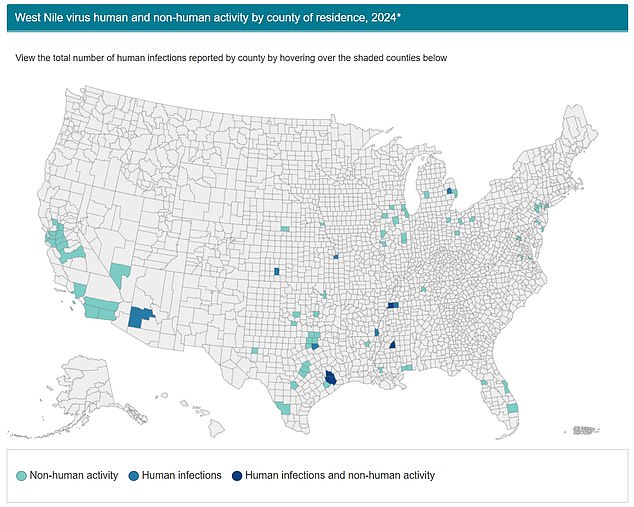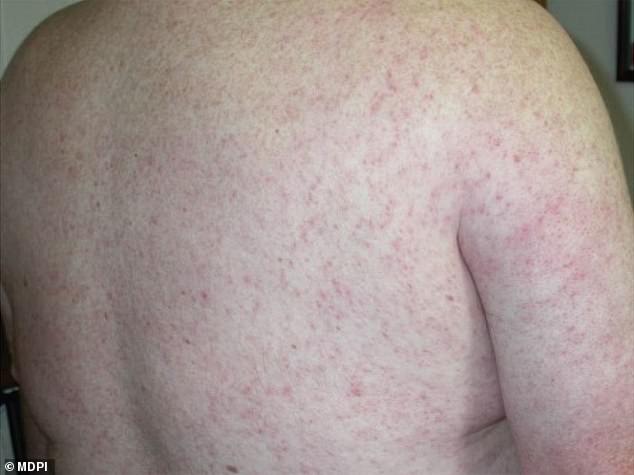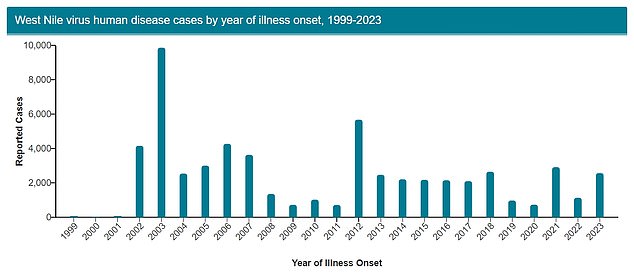Cases of West Nile virus are being detected earlier than usual this year, providing a warning sign that more people could be diagnosed with the mosquito-borne illness.
Cases usually don’t appear until July, experts say, but nine have already been recorded in 2024 in the United States.
Tennessee and Kansas both recorded their first cases in May, almost two months ahead of schedule. Arkansas, Mississippi, Maryland, Michigan and Arizona have also recorded human cases, with Colorado being the latest, reporting its first case on Wednesday.
Mosquitoes carrying the disease are also being spotted earlier than usual in states like Michigan and Connecticut, where the insects were at least a month early.
And they are being detected in record numbers in and around Las Vegas, worrying officials who say the high number of infected mosquitoes increases the risk that more people will become infected.
No deaths have been reported so far.

The map above shows areas where West Nile virus has been detected in mosquitoes (light blue) or people (dark blue) so far this year. The season normally begins in late July in much of the country, but officials are concerned about this year’s early start.

About one in five patients develop symptoms of West Nile, which can include a rash, pictured above. Less than one percent of them end up suffering a severe form of the disease.
Dr. Thomas Moore, an infectious disease expert in Kansas, told DailyMail.com it was certainly “unusual” to see so many cases at this time of year.
But he added that it was difficult to determine whether this would lead to a larger outbreak in the United States because – since the virus has been in the country since 1999 – many people are now already immune.
“Having a significant number of cases this early in the year could actually be a sign of global warming, with mosquitoes being active earlier,” he said.
“This is something we can expect more of in the future, and not just with West Nile but also with dengue, which would indicate that the situation is getting worse.”
Yesterday, the CDC issued a health alert about a surge in dengue infections, saying this year’s toll was already “higher than expected.”
In Las Vegas, officials usually find 6,000 mosquitoes in traps from April to June. But this year, they’ve already found 24,000, nearly four times the normal number.
Of the mosquito pools or traps that caught the insects, 169 tested positive for West Nile virus — meaning at least one mosquito was infected — breaking the record set in 2019.
Of the nine patients reported so far nationwide, five were suffering from a severe and potentially fatal form of the disease.
Sounding the alarm on the emerging situation, Kansas health officials said: “Although cases of West Nile virus occur annually in (our state), the concerning trend this year is their unusually early onset .
“Typically, West Nile virus cases begin in late July and early August, but we have already received reports of two cases this year (in May).”
In Michigan, officials echoed: “This discovery (of infected mosquitoes) is earlier than in previous years, indicating the need for increased vigilance and preventive measures. »
In Las Vegas, officials said, “This year is unprecedented. We recorded the highest number of mosquito groups testing positive early in the transmission season.
“It’s only the end of June or the middle or end of June. This will last until October. So we are very worried. »
Vivek Raman, environmental health manager for the Southern Nevada Health District, added: “This is a huge number of mosquitoes, and we have already identified a concerning number of them carrying West Nile virus . »

The table above shows the number of cases reported per year from 1999 to 2023. Cases have remained stable in recent years.
Cases of West Nile virus have increased in recent years, with around 2,500 cases recorded last year, more than double the 1,130 cases recorded in 2022.
Experts say these numbers are likely a vast underestimate because most people who catch the virus are not tested.
Every year, around 150 deaths are due to this disease.
West Nile virus is endemic to the United States, with the first cases appearing in 1999 – likely after being imported from another part of the world where the virus was more prevalent.
People contract the disease from bites from infected Asian tiger mosquitoes – distinguished by their black and white striped markings – which catch the virus from birds.
About one in five people have symptoms, such as fever, headache and a rash covering the trunk, head, neck, fingers and toes.
These can last from a few days to several weeks, with patients being treated with fluids, bed rest and over-the-counter pain relievers.
Of those with symptoms, less than 1% will develop severe disease. – called West Nile neuroinvasive disease (WNND) – which can be fatal.
In this case, the virus infects the brain and causes encephalitis, or inflammation of the organ, leading to seizures, disorientation and coma.
About 3 to 15 percent of patients with WNND die from the disease, with death sometimes caused by infection with the virus and shutting down the cells needed to send impulses to tell the body to breathe.
Young children, adults over 50 and those with weakened immune systems are most at risk of this severe form of the disease.
Experts say mosquitoes are active earlier this year because of warmer, more humid weather in many parts of the United States.
They are expected to remain active until October, during which time people are at increased risk of infection.
And other mosquito-borne diseases, such as dengue fever, are also of concern.
To protect against West Nile virus, officials have advised people to wear insect repellent and long-sleeved tops and pants in the evening and early morning, when mosquitoes are most active.
Individuals have also been advised to eliminate any standing water near their homes, as this can be a place where mosquitoes can breed.